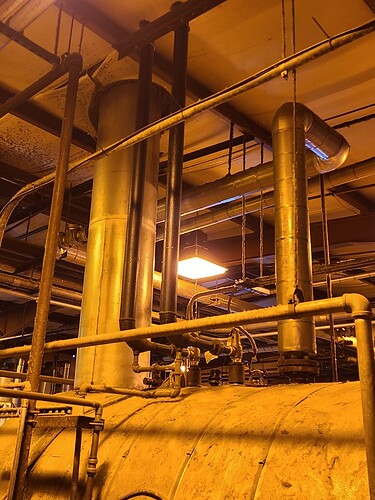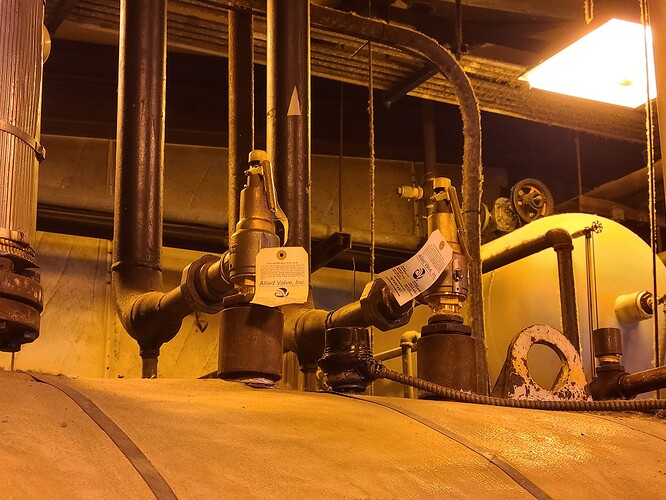I am very experienced on ASME Section VIII PSV sizing, but hardly have any experience on ASME Section I PSVs.
One of our plants has two 150 HP boilers with MAWPs of 150 psig. Each boiler has > 500 sq. ft. of heating area, so I know each boiler requires two PSVs.
After reading through ASME Section I, both PSVs will have set pressure of 150 psig with 3% overpressure. Both PSVs are existing and conventional. They are all Kunkle model numbers 6021-GF01-AM.
The plant wants to pipe the outlet of all 4 PSVs outside of the boiler room/building.
So, given all this, what is the maximum allowable pressure drop on inlet pipe and fittings and outlet pipe and fittings for Section I PSVs?
I know for ASME Section VIII PSVs the maximum allowable pressure drop for conventional PSVs are 3% on inlet and 10% on outlet. With only 3% overpressure for Section I PSVs, those don’t feel right to me. I didn’t see any mention of maximum allowable pressure drop for ASME Section I PSVs in ASME Scetion I, API 520 Parts 1 and 2, or API 521.
Can somebody help me or point me to a resource on this?
PG-71.3 of ASME Section I states that the pressure relief valve shall be connected to the boiler independent of any other connection - i.e. effectively no intervening piping (or as close as possible if both valves share an inlet connection, in which case stipulations are made). Section I simply states that discharge pipe shall be not less than the full area of the valve outlet and shall be as short and straight as possible.
Also, note that Figure PG-58.2-1 shows that the discharge piping of the safety relief valve is governed by B31.1. I recommend you review the requirements and guidance there - from memory, I think you really just need to design the discharge piping and confirm no blowback will impair the valve. I’ll try to look back through B31.1 in the next day or so and refresh my memory so I can be more helpful.
1 Like
Thanks, Koach. Each PSV has it’s own separate and independent boiler nozzle to connect to. They are close to each other. There is no intervening valves and no pipe on the inlets; just a coupling and one or two bushings to change the connection to the 1-1/4” MNPT of the PSVs.
It seems to me that Sect. I lays the burden of determining how much pressure drop can be tolerated on inlet and outlet pipe and fittings on the “manufacturer”. API 520 Part I says, “The rules for overpressure protection of fired vessels are provided in ASME BPVC, Section I and are not within the scope of this standard.”
So, I spent some time exploring Kunkle’s website today. I found one installation guide that clearly covers Sect. I PSVs that said,
“2. When discharge piping is connected to valve
outlet, make sure it is self draining if a body
drain port is not used. The valve should not
be connected to any discharge pipe that
contains pressure before the valve opens or
to any pipe where the pressure build-up is
greater than 10% of the set pressure when
the valve is open and relieving.
Discharge piping, other than a short tailpipe,
must be supported. For steam service,
a drip pan elbow or flexible connection
between the valve and the pipe should be
used to prevent excessive pipe stress, due to
thermal expansion, from being imposed on
the valve body.”
So, I have an answer. Outlet dP no greater than 10% of set pressure. With the existing installation, as pictured above, outlet dP is calculated at about 20% of set pressure. My plan is to modify the outlet piping. The existing 1.5" pipe screwed into the outlet is over 1 ft. in length; and this is where we have Mach 1 during discharge. I’m going to go with at most a 2" long half nipple with a 1.5" x 3" reducer butt welded to it, then tie it into the existing pipe with a 3" union close to the reducer to make T&I easy. My calculations show this set up will be about 8.5% of set pressure.
Comments and corrections will be appreciated.
1 Like
I agree with your conclusions above.
Section I does tend to lay a lot of responsibility at the feet of the manufacturers and, 9 times out of 10, their standard guidance keeps you covered. With a relatively low pressure and steam capacity to be relieved in this case, I believe Kunkle’s guidance to be more than sufficient.
I looked back through B31.1 this morning and I will offer one additional resource from that code if you have it available; I don’t believe it changes anything for you here and only offer it as a future reference FYI. Nonmandatory Appendix II of B31.1 has guidance for the design of PSV installations with various discharge arrangements, from open vent pipes to closed discharge systems. This appendix includes methods for evaluating stresses where applicable, as well as confirming that blowback will not reseat the valve before steady state discharge is achieved.
1 Like
I don’t think I’ve ever looked at B31.1 in much detail. I’ve relied on our pipe specs to keep out of trouble. But this sounds very interesting to my PSV sizing psyche, so I’ll download B31.1 from TechStreet and have a look. Thanks!!!

